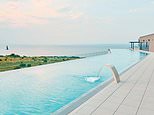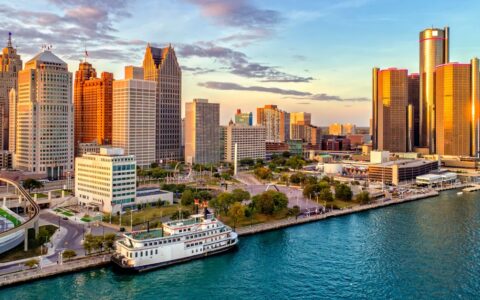
Beneath me spreads a verdant headland of tousled trees bounded by bright blue sea, with a tiny triangle sailing across it.
I swim a few more metres and this calming panorama continues. And I swim some more and some more.
I am in Europe’s longest infinity pool, at 105m it’s longer than pools at the Olympics, on the roof of the new Petram Resort in the northwestern corner of Croatia.
It’s not the only swimming on offer at Croatian Istria’s latest resort complete with smart, unfussy apartment-rooms (where children and pets are welcome), tennis courts, a spa and a rooftop restaurant looking out across the Gulf of Trieste.
There’s a garden pool that’s nearly as big and just a three-minute walk (or a hotel buggy ride) away are the silky, clear waters of the Adriatic.
Juliet Rix checks in to the new Petram Resort, which is home to Europe’s longest infinity pool (pictured), which measures 105 metres in length. The resort is located in Istria, a peninsula in Croatia’s northwest
The pool is ‘longer than pools at the Olympics’ and is situated on the roof of the hotel
There are bathing spots all along this rocky coast, and the sea is warm enough for swimming from June to the end of October.
‘People used to come here primarily to swim,’ says winemaker Moreno Coronica, as we sit a few minutes’ drive from Petram, surrounded by the red earth vineyards his family has cultivated for generations.
‘And then they might drink some wine but now it’s also a gastronomic destination.’
It is indeed, with Michelin-style menus at gastropub prices.
Almost everything here is bilingual. This area was ruled by Italy (Ancient Rome, medieval Venice, modern Rome) for about half of the last two millennia.
Ancient Rome can take some credit for Istria’s culinary successes since they introduced the cultivation of vines and olives.
Colourful: Juliet says the region’s coastal scenic centres such as Rovinj (pictured) are well-worth a visit
Above, Petram’s garden pool, which is just a three-minute walk away from the waters of the Adriatic
Excellent olive oil graces almost every table, and I have fun learning how to taste it properly (front of the tongue, then suck air through your teeth and wait for the spice).
The Romans left a more solid legacy, too – in the peninsula’s largest town, Pula (1½ hours from Petram), which is dominated by the arched honeyed-stone ellipse of its well-preserved gladiatorial arena.
The departure of Italians when this area became part of communist Yugoslavia in 1945 turned many places into ghost towns, but some have since found a new lease of life and they’re as well worth a visit as the region’s coastal scenic centres such as tourist favourite Rovinj.
When I arrive in Groznjan, Mozart wafts from the solid stone medieval Kastel, now a concert hall. And tucked in the tiny streets of flower-decked historic houses are some 30 studio galleries. This colourful artists’ colony is small, but not to be rushed.
Juliet visits Motovun (pictured), Istria’s best-preserved Venetian fortified town
Above – the ruins of a Roman amphitheatre in Pula, the peninsula’s largest town
TRAVEL FACTS
Juliet travelled with the Croatian Tourist Board and Petram Resort.
Apartments start from £160. Ryanair (ryanair.com) London to Trieste from £31 return and Easyjet (easyjet.com) London to Pula from £67 return. More details: istra.hr/en.
A couple of hilltops away perches Motovun. Up 277m and some 1,000 medieval stone steps (don’t worry, there is also a road), this is Istria’s best-preserved Venetian fortified town.
I pass the Palladian Renaissance church and its 13th-century campanile, originally a defensive watchtower said to have been shaken in frustration by the town’s legendary largest resident, Giant John, the subject of a nearby mural. I wander the city walls and enjoy views over the Motovun Forest, which used to supply Venetians with wood.
Today, it is equally valued – for truffles. I meet truffle hunter Nikola at the edge of the forest in Livade, self-proclaimed ‘world centre of truffles’. Black truffles, he says, are year-round fungi that can be cultivated, but white are autumnal, only wild and wildly expensive. The priciest, a 1.5kg whopper, sold for £237,000 in 2007.
‘We may find nothing,’ says Nikola, as his dog Zara starts snuffling the ground. Instantly, Nikola is on his knees, his head to hers, frantically digging.
Moments later, he sits back, incredulous. In his palm is a sizeable white truffle. It is broken, halving its value, but will taste the same. But would I pay through the nose for it in a London restaurant, without the fun of watching the dog nose it out?
I’d rather spend it on travelling to Istria, and have my truffle served along with history, music, art, wine, olive oil, sweeping scenery and swimming.
Source link
CHECK OUT: Top Travel Destinations
READ MORE: Travel News



